by Karl-Heinz Stadtler 2006
Translated by Kimberley Simon
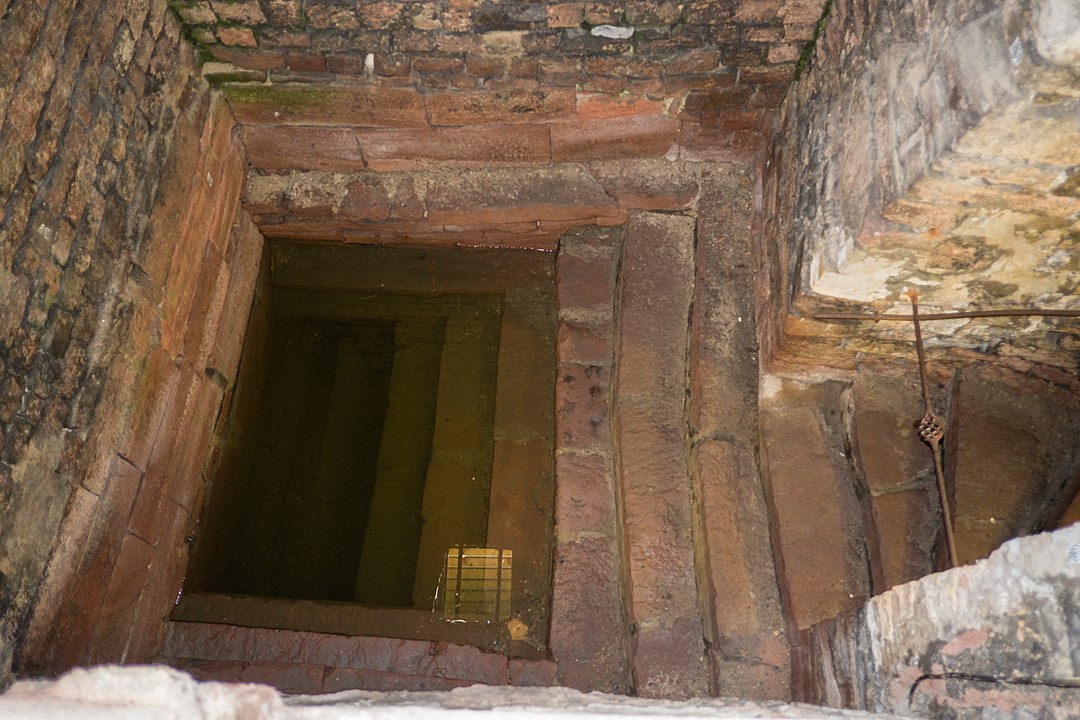
read more
- Suprising find in Volkmarsen
- Water cleanses
- Biblical foundation for the Mikveh
- The occasions for the use of the Mikveh
- Construction and the way it’s used
- The Mikvaot of the Jews in Vöhl, Marienhagen and Basdorf
It was quite a sensation when Ernst Klein, chairman of the association “Rückblende” in Volkmarsen, reported having found an approximately 500-year-old mikvah in a house in the town center of Volkmarsen. He had suspected this for a long time, but now it was proven by excavations and scientific research: In a house built in the 13th century with a very special cellar vault, a shaft mikvah was installed in the 16th century.
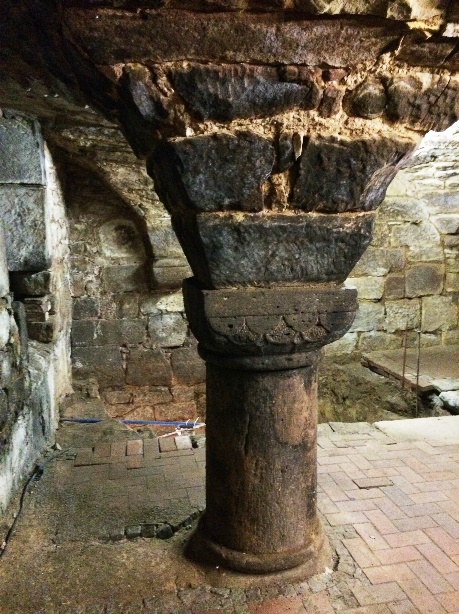 One of the vault columns Photos: Karl-Heinz Stadtler |
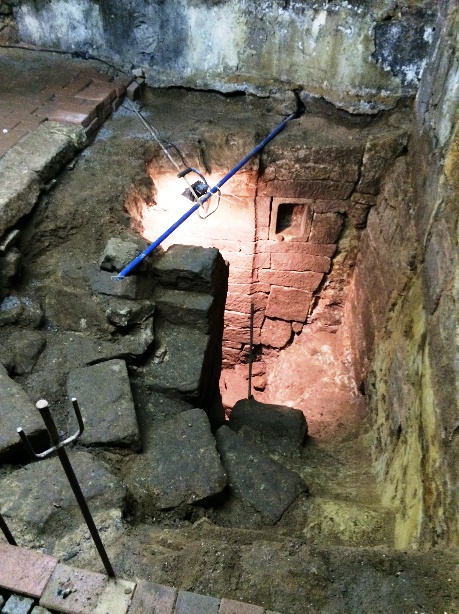 Stairs to the mikveh with shelf |
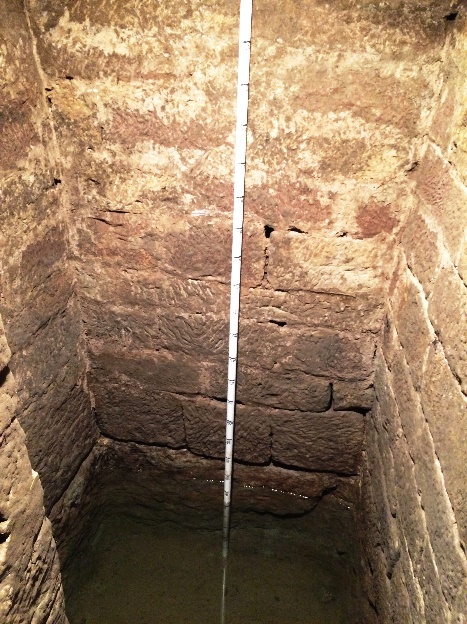 Shaft mikveh in Volkmarsen |
Of course, it was no surprise that there was a mikvah in Volkmarsen. Such a ritual immersion bath was located in the synagogue built in 1827. The special thing was the age of the now found mikvah, because the finding proved that already in the 16th century Jews lived in the city.
But first of all, what is a mikvah?
Water cleanses- literally and figuratively!
Anyone who has worked all day - building a road or a house, in a factory or a repair shop, in a kitchen or a garden, in a stable or in the fields - appreciates a shower in the evening. Even if you didn't get dirty at work, maybe didn't even sweat, you feel fresh and cleansed after a shower or bath.
Wounds are cleaned with water before they can be treated. Surgical instruments or other medical equipment are cleaned before use. The risk of infection is eliminated by using water with appropriate additives.
The cleanliness of the home, of clothing, of rooms where food is produced or sold, of hospitals are criteria of healthy living for us. And despite all chemical or biological additives, the most important cleaning agent is still water.

On the other hand, we are familiar with the television or magazine pictures of thousands of Hindus immerging into the brown and dirty but sacred waters of the Ganges to ritually wash themselves, because the bath is also supposed to cleanse one from the evil done or experienced. This rite was certainly introduced at a time when the water of the river was not yet harmful to people's health.
 Holger.Ellgaard, Skondals kyrka 2005, CC BY-SA 3.0
Holger.Ellgaard, Skondals kyrka 2005, CC BY-SA 3.0
Baptism is also an exclusively ritual cleansing: a handful of water with which the priest strokes the child's head symbolically cleanses from sins and at the same time welcomes the child into the religious community. There are also Christian communities where full body baptism is common or even mandatory.
Ritual cleansing with water is also of great importance in the Jewish religion. It goes back to the books of Moses, where the need for cleansing is emphasized in various places in the Torah. The first passage (Leviticus 14:8) deals with the cleansing of lepers, of whom there were many at that time. There it says in the Holy Bible, New International Version:
- “The person to be cleansed must wash their clothes, shave off all their hair and bathe with water; then they will be ceremonially clean. After this they may come into the camp, but they must stay outside their tent for seven days.
- On the seventh day they must shave off all their hair; they must shave their head, their beard, their eyebrows and the rest of their hair. They must wash their clothes and bathe themselves with water, and they will be clean.”
The 15th chapter of the same book deals with a man's discharge from his genitals, semen that is ejaculated during sleep, and a woman's menstrual cycle: the people involved, as well as everyone with whom they have come in contact with, and also all objects they´ve touched, are considered unclean and require ritual cleansing.
In addition, there is a whole series of other regulations in which cases the mikvah is to be used. Only after that, the attendance at religious services is allowed again. In the 4th Book of Moses in the Holy Bible, God commands to punish those with death who does not keep these purification commandments. The literal translation (Numbers 19:10-13) reads:
“10. This will be a lasting ordinance both for the Israelites and for the foreigners residing among them. 11. Whoever touches a human corpse will be unclean for seven days. 12. They must purify themselves with the water on the third day and on the seventh day; then they will be clean. But if they do not purify themselves on the third and seventh days, they will not be clean. 13. If they fail to purify themselves after touching a human corpse, they defile the Lord’s tabernacle. They must be cut off from Israel. Because the water of cleansing has not been sprinkled on them, they are unclean; their uncleanness remains on them.” Thea Altaras thinks that those translations did not correctly quote the source. In the Jewish version of the text, the sentence has a different meaning.
Since Isaiah, ca 500-400 BC, it is mandatory to wash thoroughly - with soap - before diving into the water, the "pre-washing".
To the Jews who had become pagan, God says through the prophet Ezekiel (36:25) “ I will sprinkle clean water on you, and you will be clean; I will cleanse you from all your impurities and from all your idols.” The prophet Isaiah tells his fellow believers (12:3) “With joy you will draw water from the wells of salvation.”
In the Letter to the Hebrews, the unknown author urges the addressees (10:22): “let us draw near to God with a sincere heart and with the full assurance that faith brings, having our hearts sprinkled to cleanse us from a guilty conscience and having our bodies washed with pure water.” The Christian author of these lines here expresses the cleansing with water still completely in Jewish tradition; the Christians of his generation may still have used the mikvah.
In Germany, the mikvah is often referred to as the "women's bath" because it is mainly visited by women after their menstruation. They are not allowed to have sexual relations until they have "immersed" on the seventh day after the end of their menstrual period. Before that, however, they wash or bathe themselves in order to enter the mikvah with a clean body. Women also use the mikvah before marriage and after childbirth.
Some Orthodox men still follow the old custom of going to the immersion bath before Sabbath and before high holidays.
Dishes are also ritually cleaned in the mikvah: both the dishes that one has just bought new and the dishes that one intends to use for meaty things but which might previously have been used by others for "dairy" things, or vice versa, and finally dishes and other containers or clothing that have come or might have come into contact with animals considered unclean or the remains of unclean or even clean animals.
Items purchased from non-Jews require an immersion bath.
Linen or clothing that has come into contact with impure bodily fluid is also ritually cleansed in the immersion bath.
Originally, there were more occasions for the use of the mikveh.
In the past, the mikvah also had to be used by priests before services. And finally, converts, i.e. people who converted to Judaism from another religion, have to take an immersion bath; in this respect it is somewhat similar to Christian baptism.
It is pointless to ask why ritual cleansing is necessary in all these cases. Sometimes it is argued with health reasons, but then it is implied, firstly, that it was not always exclusively a ritual, but historically also an actual cleansing; and secondly, there are cleansing occasions that cannot be justified medically. Perhaps it is just our mindset, our way of thinking, which demands rational reasons. For devoted Jews it is enough and must be enough that there is a corresponding commandment of God; the question of "why" does not arise then.
Not every Jew uses the immersion bath. As in other religions, Jews are differently religious. Moreover, the question of whether or not a bath in the mikveh is necessary, and in which cases, depends not only on one's personal intensity of faith, but also on which of the many branches of Judaism one belongs to: Is one more Orthodox or more Reform? Does one come from Eastern or Western Europe, from the USA or South America, from Africa or an Asian country? Do you live in regions where water is plentiful or do you live in a desert? Different origins certainly have an influence on whether or not certain rites are observed, and if so, in what way.
What was described at the end of the previous chapter also applies to the structural design and the way in which a mikvah is used, perhaps even more so, because with regard to the occasions for ritual cleansing, one can still refer to the regulations of the Torah, to God's laws. But when it comes to the question of what a mikvah should look like and how men and women should bathe in it, the Torah is of no help. Here there are the rabbis who have discussed and established rules over the centuries - often in discussion and debate with others. There may be common ground that applies to several religious directions, perhaps even to all Jews, but there are also quite significant differences. Not all the statements of the ancient teachers are clear; interpretations are often necessary. Rules are also modified or changed due to changing lifestyles and the development of new building materials. One assumes - rightfully so - that this or that teacher a thousand or even fifteen hundred years ago in Spain or in Central Europe or in the Near East developed his teachings on the basis of the conditions given then and there, that they are not easily transferable to the present and are therefore adaptable. Such adaptations and transmissions are also made today by rabbis in their examination of the ancient texts and in discussion with other scholars and teachers of the faith. Thus, even in the present day, there are differences in terms of the structural design as well as the way in which a ritual bath is used.
The most important written basis for any discussion of this question is the section on the "mikvaot" (plural of mikveh) in the Mishnah, which was compiled around the year 200 based on the work of even older teachers by Rabbi Yehuda and forms the basis of the Talmud. In ten sections, it goes into all the details and deals in particular with the cases in which the immersion bath is ritually invalid.
Incidentally, not every rabbi claims the right to decide on the installation of a mikveh. Thea Altaras, who as a Jewish architect is a specialist in the religion, rites and culture of Judaism, writes in her two books on the ritual immersion bath, published around 1990, that there is currently no one in Germany who is confident enough to decide on questions of the installation of a mikvah. In Giessen, where Mrs Altaras lived and worked, a rabbi from abroad was brought in to avoid mistakes that could, in extreme cases, invalidate the ritual bath. The name of the rabbi responsible is attached to the immersion bath (building plaque) in Giessen. He therefore now also subsequently vouches for a facility that complies with the "Halachah", the Jewish religious laws.
The Hebrew word mikva or mikveh means a collection or damming of water. Natural water - a river, a pond or lake, a sea - or an artificial bath, the water of which has not been scooped with a vessel or reached the immersion tank by human hand, can be used for this purpose. A flowing body of water can only be considered ritually suitable if it contains a quantity of spring water or - perhaps depending on the time of year - at least some rain or melt water; the reader of these lines will realise that even in this case one must "interpret" and "reinterpret" in order to act in accordance with the rite. In the immersion basin, however, only ground water is allowed to "flow", otherwise it must be standing water.
There are very specific requirements for a built mikvah: it must be deep enough to allow complete immersion; according to Kolatch, it must hold at least 762 litres of water and have an inflow of "living" water, i.e. be fed from a spring or a river. Thea Altaras states a minimum capacity of 250 to 800 litres of water, which is enough if the person can be completely submerged in the pool.
She distinguishes between three types of suitable water for a ritual immersion bath: 1. ground or spring water, 2. "accumulating" water, by which she means rainwater or melted snow, and 3. flowing water. Depending on the type of water, the construction of the mikvah varies. It is not necessary to go into detail about this for the purpose of this paper. Those who are interested can read about it in the book by Thea Altaras.
Wherever possible, mikvaot are built near rivers in order to use river water for bathing, especially since the groundwater level is usually higher near rivers or streams. Now and then, however, a deep shaft is dug down to groundwater level in order to be able to build a bath that complies with the rules and the relevant water reservoirs.
 A woman purifies herself in a mikvah, while her husband waits for her in bed. Germnany 1427/28 Photo: public domain |
 Cleaning of dishes in the mikvah. Photo public domain |
The ritual immersion bath requires thorough preparation. Food regulations must be observed, the body must be thoroughly cleaned and all things foreign to the body (rings, even prostheses and hairpins) must be removed. The body is then immersed down to the last tip of the hair, making sure by posture, finger spreading etc. that every part of the body is in contact with the water. Eyes and lips are only slightly closed.
Visitors to the synagogue in Vöhl often ask about the mikveh because they know from other places that this feature is almost always, or at least very often, located in the synagogue building. This applies - as mentioned above - to Giessen; but also in Weimar-Roth, where they restored the former synagogue a few years ago, the mikveh was right next to the building.
In Vöhl it was different. There was never a mikveh in the synagogue. On the basis of historical documents, we can now show how the Jews of our region and the state authorities dealt with the Jewish ritual baths.
A letter from the Grand Ducal Government of Darmstadt dated July 17th, 1813, is the oldest document we have on this subject. It praises Jewish law, which commands women to purify themselves after menstruation or childbirth (the government obviously did not recognise the ritual nature of this purification either), but the law is "misused by the Jews to disturb and undermine the health of the female sex"; the women's bath is usually a deep hole in the cellar of the house with ice-cold spring water, which results in "the most incurable blood flows, emaciations and nerve infections (!)". So the government demanded the construction of warm baths, which did not happen.
Five years later, on June 17th 1818, the physicus (= doctor) Goldmann from Vöhl reported to the government in Gießen about eleven baths in the district of Vöhl, including three in Vöhl itself and one each in Basdorf and Marienhagen. All of them - including those in Höringhausen, Altenlotheim and Eimelrod - were "without exception, very harmful and reprehensible". Then he describes them in more detail:
"They are all in cellars, some vaulted, some low, barely 5 shoes high, damp, dull, with beams, some of which have light, others dirty, very foul-smelling, and cold, nasty spring water, which is constantly open in such a cellar hole, and is polluted by all kinds of things. The bathing women must undress and dress in these cellars, or go naked from a parlour into such a cellar, and from there back into the parlour, where they dress, so that one is surprised that far more of these women do not get ill.
He admits that it is not possible to build "a harmless bath" everywhere, but says regarding Vöhl
"The Jews, of which 8 families live here, are all wealthy, some even very rich, but up until now, although they themselves very much wanted a proper bath, they have not built one of their own because of disharmony; these people must therefore be forced, and then, in my opinion, they will gladly follow the order.
He also proposes similar baths for Höringhausen and Eimelrod. The Jewish women's baths in Marienhagen, Basdorf and Altenlotheim, where the families were too poor to build mikvahs in the way he wanted, were supposed to be closed down and the Jewish women encouraged to visit the baths in Vöhl. "Not only as a physicus, but also as a humanitarian", he asks the government to change the "law, which is considered appropriate, but which in fact has a murderous effect", as he suggested.
Again two years later, the government in Giessen seems to want to become more forceful: On January 15th, 1820, it calls on the Vöhl magistrate to finally do something about the situation. The Jewish community gives in, confirms the hygienic problems regarding the baths through Selig Salomo Rothschild and applies for a new building, which the government approves, but then nothing is done for another four years. In January 1824, the government again requests a status report on the baths, which Vöhl delivers in February. The letter describes the conditions as bad as the physicus' report of 1818, but also comes to the conclusion that at least the "Jews at Altenlotheim, Marienhagen and Basdorf could have new harmless baths, but they would not be able to invest in new healthy ones. Now, however, the government finally wants to see action. In January 1825, it asks Krebs, the district administrator of Vöhl, to begin "burying" the baths within 14 days. The district administrator does not hurry: only after the deadline has expired he addresses this request to the mayors of Vöhl, this time setting a deadline of four days. The mayor reports "that the Jews in the community of Basdorf no longer have any earth baths in front of the Jewish women. Feidel Keiser has a well in the cellar which used to be for this use, but he used it as a well for his family. And the mayor of Marienhagen answers firmly: "... there is no earth bath in Marienhagen."
Although it is difficult to read because of the unfamiliar language, the letter sent to Gießen by Krebs, the district administrator of Vöhl, on February 25th, 1825, is quite interesting:
"As a result of the order above, the mayors were immediately instructed to have all the Jewish earth baths buried. The mayors were immediately ordered to have all Jewish earth baths buried, but complaints were filed from all parts of the city, which led me to withdraw the order. The masters of these baths are not only used as such, but at the same time serve either as wells for the cattle, or in the cellars, where no drain can be installed, to collect the water to a point, and are then also very useful for fires, especially here in Vöhl, where there is a lack of water containers.
However, in order to achieve the purpose intended by this high bull [=law], and at the same time to satisfy the rightful wishes of the bath owners, I have ordered the Jewish community here at Höringhausen and Eimelrod to provide their baths, if they have not buried them, with well casings that make their use as such impossible, and to construct a bath in each of these places (the others Marienhagen, Altlotheim and Basdorf have no baths at all) within 4 weeks at joint expense, which the District Court Physician has declared not to be harmful to health. . For the time being, I would like to report this, adding that I will not fail to report the results of this order after the set deadline, if it is not otherwise disapproved by th higher government.
On March 8th, Giessen criticized that the district administrator had not been happy with burying mikvaot, but had also ordered the Jewish communities to build a communal bath. He should take back this part of his instruction, it was his task "only to remove those devices which are damaging to health".
Surprisingly, the district administrator does not follow this order. Five days later, he calls on Mayor Küthe to provide earthen baths that have not been buried with well casings that make it impossible to use them as mikvahs, and to build at least one new bath in each village in compliance with the regulations of the district physicus. He expressly permitted private baths and freed their owners from sharing the costs of the communal bath.
As early as 21 April 1825, district physicist Braun confirmed in a certificate "that Bär Katzenstein had given his bath such permission that it is now quite suitable. (What probably meant that Bär Katzenstein set up the mikvah in his house in such a way that it was suitable for approval).
However, it is unclear whether Bär Katzenstein is actually being referred to, because District Administrator Krebs mentions Simon Katzenstein to the Giessen government as the owner of the proper mikvah. Otherwise, the district administrator announces that all Jewish earth baths are now unusable for their original purpose.
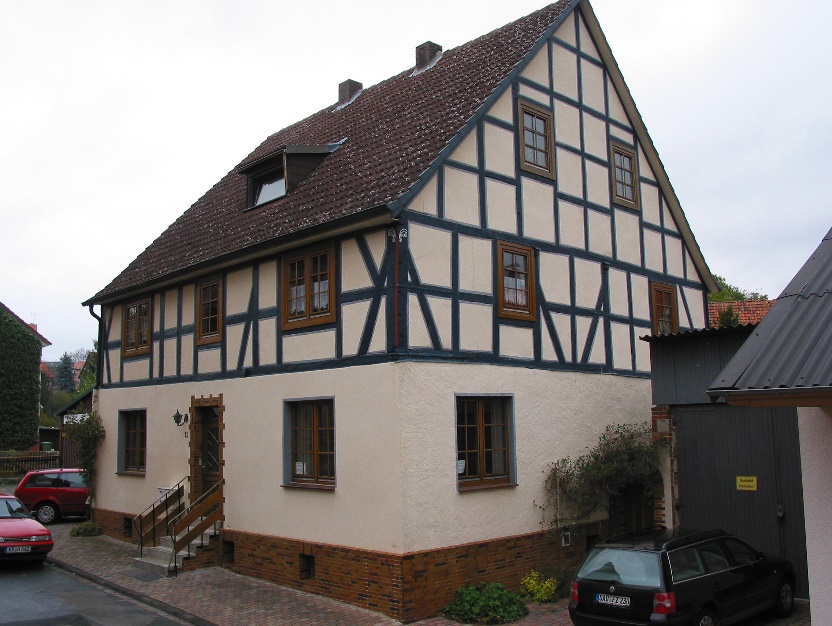
Photo: Walter Schauderna
One of the former Katzenstein houses in the lower Mittelgasse
On July 30th, an order is issued from Giessen to the district of Vöhl, listing the conditions for the construction of a proper mikvah:
- the building costs and maintenance are a matter for the Israelite community;
- the district doctor must certify that it is fit for use;
- the water must not stand for more than one day and must be drainable;
- the certifying doctor must take into account that "a Jewish bathing facility is only permitted if they use flowing spring, river or rain water, which is conducted through gutters";
- Earth baths must be walled or similarly secured;
- cold baths are prohibited; the room must be heatable;
- the stairs into the room must be made of oak;
- an inspection by the physicus must be made once a year;
- a "married Jewish supervisor" is to be provided for the bath.
In March of the following year, the government recommends to the district councillors that they draw the attention of the Jewish communities to a paper by Birkenstein, a Jewish teacher from Battenberg, in which he deals with the "bathing of Jewish women" and which is very useful.
In 1835/36 the Mikwahs again become a discussion topic.
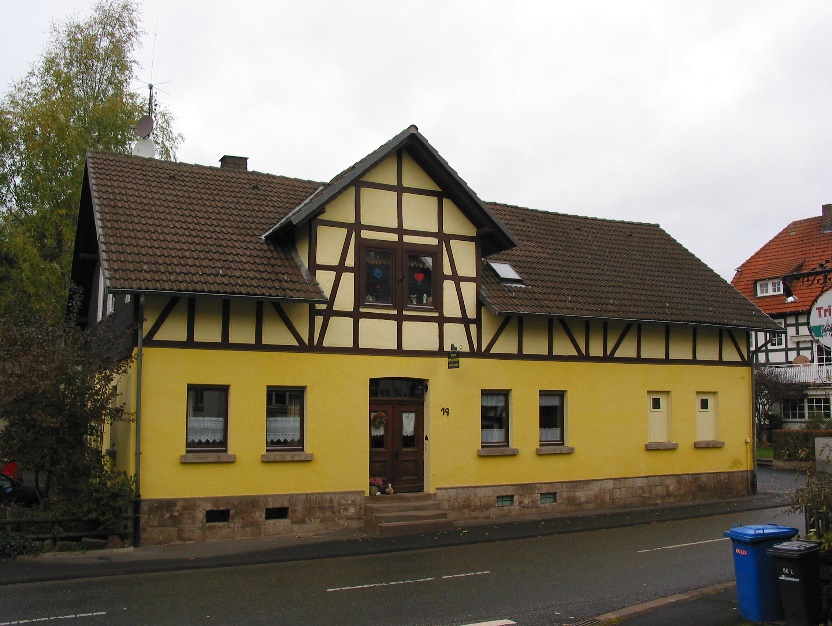
Photo: Walter Schauderna
Selig Stern's house used to stand here, and there was a mikvah in it.
The picture shows a property in the Arolser Straße, on which 3 houses of Jewish families used to stand; also the house of the Schönhofs, in whose cellar there was a mikvah.
back↑
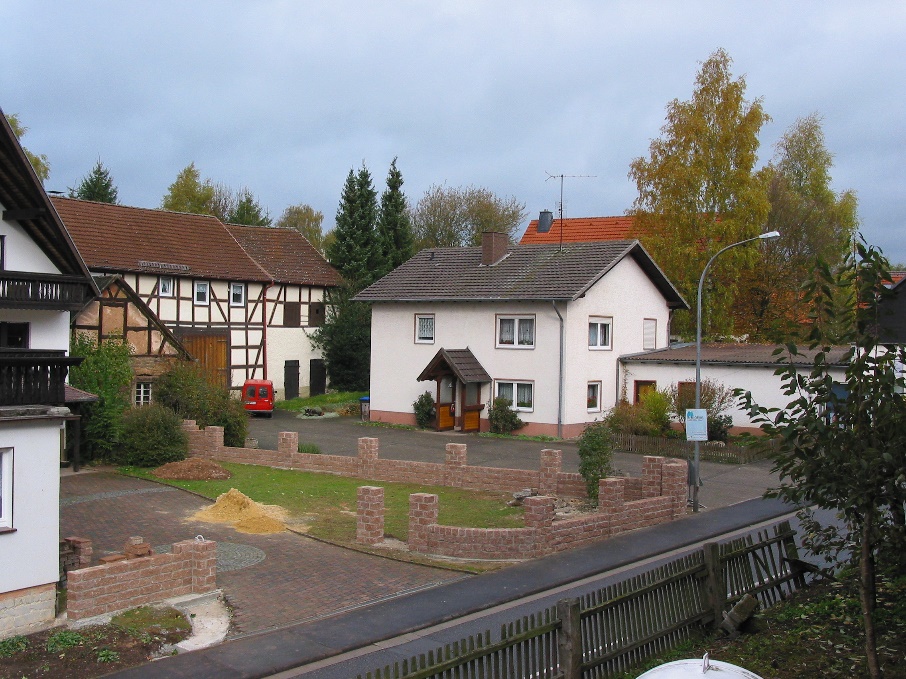
Photo: Walter Schauderna
The Schönhof house with a mikvah, among other things, stood on this property.
Mayor Knoche from Marienhagen visited the cellars of all Jewish families, but "found no wells or bathing holes in any of them. The new doctor, Dr. Nuß, found a different situation in the other towns in the district. In Altenlotheim and Höringhausen he found one bath each, in Eimelrod two; furthermore "one in Basdorf in the home of Feist Kaiser ...and three in Vöhl in the homes of Selig Stern, Joseph Kugelmann and Ascher Rothschild." With the exception of the baths in the Rothschild house, all were unsuitable, small holes in dull cellars, with bad, foul-smelling water, sometimes only accessible with great difficulty. The Rothschild women's bath was also suffering from these defects, but had an elegant appearance, even the very "practical facility ... that heated water can be fed directly into a kettle installed above the bath. Dr. Nuß forbade all except Rothschild to use their baths and informed the mayors involved accordingly. Selig Stern and Joseph Kugelmann explained "that they had not used them for bathing for a long time - but that they could not have them closed for the reason - because otherwise the cellars would be full of water", a statement that the physicist did not want to doubt. Dr. Nuß wanted to have the Jewish communities pay for the inspection of the baths; the Basdorf Jews do not seem to have agreed, because in October 1836 they were still threatened by the district council with garnishment because of the 1 ½ gulden fee.
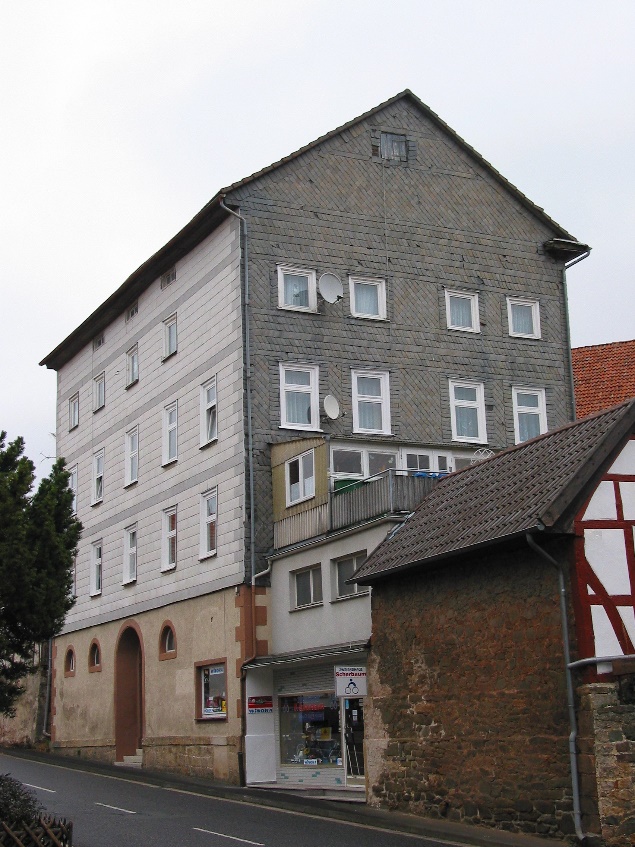
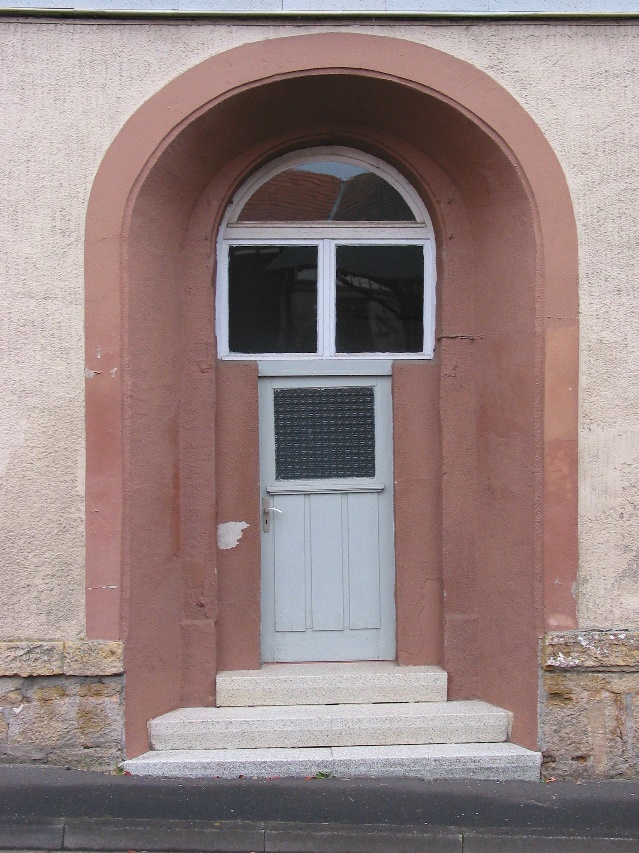
Photos: Walter Schauderna
House of Ascher Rothschild with the door to the presumed mikveh
In June 1840, written communication about the women's baths continued. There were also voices within the Jewish community calling for new baths. For example, the fruit and cattle trader Moses Schaumburg, a member of the Jewish community council, wrote to the Vöhl "Gerichtsrat" (court council) on June the 26th: "According to the supreme decree of 1831 of the RGb No 77, the women's baths for the Israelites should be set up in such a way that they do not harm the community as a whole! Unfortunately, this is not the case here - I reported this matter several years ago. He continues: "I therefore request the Gr. Greisamt to order that the goal is finally getting achieved, and a new women's bath for the Isralite community is built according to the highest decree, which is certainly an important need, and must therefore ask for an early decree". With reference to Schaumburg's letter, the District Council asks the Jewish community to "give the matter consideration, consultation and send in a report.”
On July 6th, the merchant and dyer Salomon Kugelmann, living in house No. 26, today Arolser Straße 23, and Moses Schaumburg answered on behalf of the Jewish community board: "1.We are willing to build a new bathhouse, but with the reservation that we will not be able to build it with our own means, because the community has built a new house of God only 10 years ago, which cost over 3000 ? and has already paid for almost all of it so if we owe such a building, we now ask the Grand Hessian Commissioner for a grand to build it. We ask for permission to borrow such capital, because we are not in a position to purchase it from our own resources. I, as Vorster Kugelmann, request an early ... (probably meaning answer or permission; the word is not mentioned in the original), because we must have a construction report from the ... "Kreisbaumeister" about it and buy a suitable bath for it."
Apparently, afterwards nothing was done. In 1853, a report on health and social services in Vöhl complains about the poor condition of the Jewish women's baths. At least one could be built in Vöhl, and "the Basdorf Jews would like to participate in this." However, the council of the Jewish community does not agree: there is no need to build a bath from the community's funds. In 1860, the district office urged again, and in 1861 even ordered the construction, but in letters from 1861 and 1862, the Jewish community, which was becoming more confident, rejected it. There were privately owned women's baths, and the community could not afford to build one because the costs would be too high.
There are no documents on this subject from the period after that; perhaps because Vöhl files from the period after 1866 were no longer collected in the Marburg State Archives, but perhaps also because the Prussian government, which was responsible for this district after the War of 1866, no longer cared about this subject. We now know of two, perhaps three privately owned Mikwaot that were available for use in the following decades. Ursula Behrend, born Mildenberg, who lived in the house below the synagogue in the Mittelgasse, says that before her time, probably before 1924, there had been a mikvah in the house of her parents: "... in the old sausage kitchen opposite the laundry room".
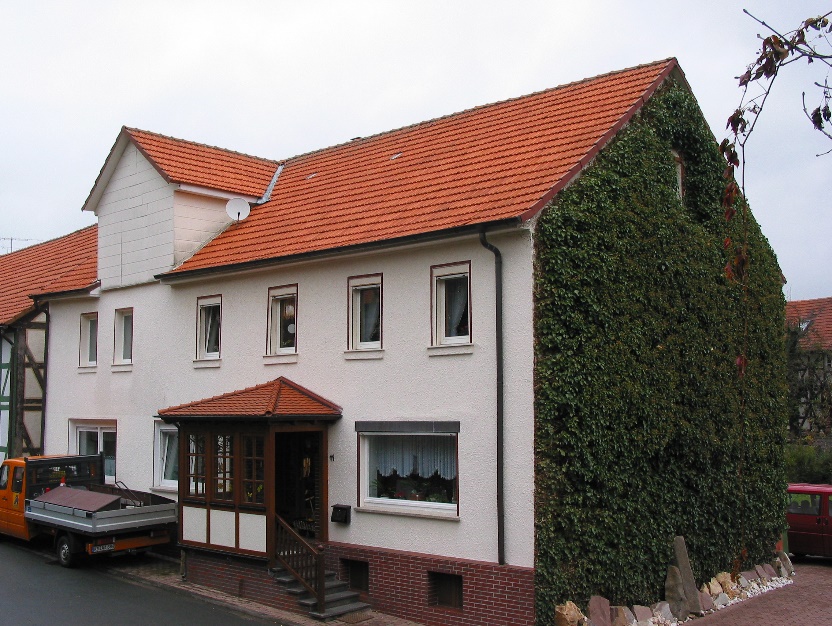
Photo: Walter Schauderna
The house formerly belonging to Sally Mildenberg in Mittelgasse, which had a mikvah in the cellar.
Mrs. Anneliese Bender, née Braun in 1913 in the house Heinze (later Ruhwedel and Urmoneit, today functioning as a retirement home) in the Arolser Straße, who was living in Vöhl until 1918 and then again during the 2nd World War, can remember that in the house of Ascher Rothschild, in the area of the bakery, there was a "well" in the house, which we certainly can imagine as a mikveh. If we further assume that there was a separate entrance to this room , as we can still see today, then this mikvah was definitely also easily accessible to the other Jews of the village.
Mrs. Krauß-Backhausen knows through hearsay that in the cellar of the house that nowadays belongs to family Demmer in the lower Mittelgasse there was a mikvah "built over the creek". This is probably the mikvah in the house of either Bär or Simon Katzenstein mentioned previously. How the formulation "in the cellar ... built over the creek" is to be understood exactly, is not quite clear yet.
An interpretation of the documents presented here on the Mikwaot in Vöhl must be made with great caution. It would certainly be rather hasty to assume that the authorities who ordered the women's baths to be filled in or made unusable were hostile to Jews. After all, statements by Jews themselves also prove that the mikvaot were in poor condition. Some formulations of the physicus Goldmann or also of the government authority in Giessen seem exaggerated, perhaps also hypocritical in relation to their concern for the health of the bath users. However, every now and then, the purpose of the measures definatly seems to be only to annoy and obstruct the community.
A distinction must be made between the attitude of the government in Gießen and that of the district office in Vöhl, at least during the term of the district council Krebs. Krebs seems to have been "closer" than his superior authority; he tries to soften directives and apparently also has the courage to decide differently from what he was told. The mayors of Vöhl, Basdorf and Marienhagen also wanted to help their Jewish community members; their reports that there were no women's baths in use in their villages were not very convincing and were probably given with the intention of helping the Jewish community to not get in trouble.
On the other hand, one also gets the impression that the Jews of Vöhl were not too faithful to the Bible or "orthodox", at least with regard to the use of mikvaot. The religious rule is one thing, its compliance quite another. Over the centuries, men in particular gradually got rid of the pressures and rules concerning the immersion bath, some openly, others secretly at first. External circumstances - their work, the social or even the rural environment - led them to become careless and finally to abandon the old rites altogether.
Perhaps adaptation and assimilation into the majority population were weaker in 19th century Vöhl than in the Jewish centres in Frankfurt or Berlin, but there was certainly a tendency for a weakening of devotion here as well.
It must have been more difficult for Jewish women to break away from the traditional obligations to immerse themselves in the bath, as they used the bath in situations that had to do with sexuality and the intimacy, since it was not talked about in public or at home. But women also became more open and free. We know from several Jewish women that they continued their husbands' businesses after their deaths. Johanna Blum even seems to have been a very successful businesswoman at the end of the 19th century.
The Vöhl Mikwaot in the 30s and 40s of the 19th century were probably in the bad condition that has been described. But one also gets the impression that they were not really used on a regular basis. They were there, and that was possibly enough to calm the religious conscience or to maintain the appearance of devotion. Surely there were people like Loeb Moses Schaumburg who insisted on the religious laws being followed, but that faded away over time.
(All quoted files are in the Marburg State Archives, fonds 111 k Vöhl 295.)
Bibliography:
Thea Altaras: Das jüdische rituelle Tauchbad; Synagogen in Hessen - Was geschah seit 1945? Teil II, Königstein im Taunus 1994 (The Jewish Ritual Immersion Bath; Synagogues in Hesse - What has happened since 1945? Part II, Königstein im Taunus 1994)
Ruth Gay: Geschichte der Juden in Deutschland. Von der Römerzeit bis zum Zweiten Weltkrieg, München 1993 (History of the Jews in Germany. From Roman Times to the Second World War, Munich 1993)
Nachum T. Gidal: Die Juden in Deutschland von der Römerzeit bis zur Weimarer Republik, Köln 1997 (The Jews in Germany from Roman times to the Weimar Republic, Cologne 1997)
Jüdisches Museum, Frankfurt am Main, Texte von Georg Heuberger, München/New York 1997 (Jewish Museum, Frankfurt am Main, texts by Georg Heuberger, Munich/New York 1997)
Jüdisches Museum, Museum Judengasse: Katalog zur Dauerausstellung, Frankfurt am Main 1992 (Jewish Museum, Museum Judengasse: Catalogue of the permanent exhibition, Frankfurt am Main 1992)
Alfred J. Kolatch: Jüdische Welt verstehen. Sechshundert Fragen und Antworten, Wiesbaden 1999 (Understanding the Jewish World. Six Hundred Questions and Answers, Wiesbaden 1999)
[3] Dem Verfasser dieser Zeilen ist ein solcher Gedanke absolut fremd: Menschen, die in festem Glauben an die Bedeutung und Wirkung des Bades dort tauchen, sind doch auch von Gott nicht deshalb zu bestrafen, weil andere bei der Errichtung der Badanlage Fehler begangen haben.



